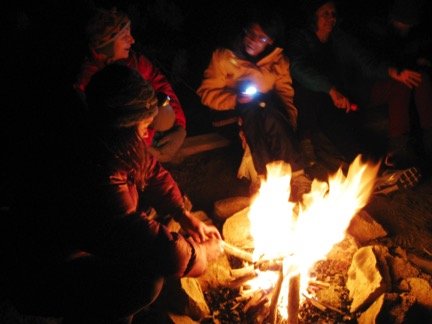Fire Season Reflections: With a Yoga Lens
 Agni, the Hindu God of Fire, is personified in actual flame, in the fire of the sun, in lightning, celestially in the stars, and in sacrificial and ceremonial fire.
Agni, the Hindu God of Fire, is personified in actual flame, in the fire of the sun, in lightning, celestially in the stars, and in sacrificial and ceremonial fire.
The word Agni is used in many contexts, ranging from the fire in stomach, the cooking fire in a home, the sacrificial fire in an altar, the fire of cremation, the fire of rebirth, the fire in the energetic saps concealed within plants, the atmospheric fire in lightning and the celestial fire in the sun. ~Jayaram V
Fire is one of the five elements in both Samkhya and Ayurvedic Philosophy According to both, the universe is composed of the 5 Elements: Earth, Water, Fire, Air, Space (Ether). Concepts like seasons and time of day can even hold the qualities of these elements.Here in California, we are well aware that this is fire season and see and experience on a daily, very gross level fires physically burning around us. We see the burning or recently burned landscape, we smell and taste the smoke in the air, and we evacuate our homes on what feels like a regular basis.When left unchecked, fire can burn out of control and be very destructive. Many of those we know have lost their homes and some their lives or their loved ones in these big fires. Fire becomes the ultimate transformer in these moments and often we are not ready for it.One of the original founders of Balanced Rock’s predecessor organization, Wild Women Workshops, had parents who lost their home in the recent Carr Fire just a month ago. The Ferguson Fire, which burned through the Yosemite Region, claimed the lives of two hard-working, local and beloved firefighters this summer. We mourn these losses of life, livelihood and homes deeply while increasing deep reverence for the power of fire. Not mentioned much is the great loss of animal life and habitat in these monstrous western wildfires: the bears burned over in Swall Meadows, the charred rattlesnake found in a coiled position by Mono Lake as though trying to defend and strike the flames, the deer family huddled together in a burned out tree stump hole that couldn’t outrun the Butte Fire.
Not mentioned much is the great loss of animal life and habitat in these monstrous western wildfires: the bears burned over in Swall Meadows, the charred rattlesnake found in a coiled position by Mono Lake as though trying to defend and strike the flames, the deer family huddled together in a burned out tree stump hole that couldn’t outrun the Butte Fire.
The Vedic people were aware of his (Agni’s) destructive ability, as he sets the forests aflame. "Urged by the wind he spreads through dry wood as he lists, armed with his tongues for sickles, with a mighty roar. Black is thy path, Agni, changeless, with glittering waves! When like a bull thou rushes eager to the trees, with teeth of flame, wind-driven, through the wood he speeds, triumphant like a bull among the herd of cows, with bright strength roaming to the everlasting air: things fixed, things moving quake before him as he flies." ~Jayaram V
But wildfire is one of ten forms of Agni described traditionally. The first five are material: and the last five are ritualistic. Fire in its healthy and balanced state consumes, transforms, purifies and conveys as it engulfs matter and reduces it to ash, transforming it from one form to another. As it consumes it morphs matter from a gross level to a more subtle level. Fire can do the same for us in our yoga and breathing practice in terms of transformation. We use the fire of our breath and the heat generated by physical postures to burn through obstacles, establishing a fertile landscape for new energy. This is something we can witness in our outer landscape in the springtime after the rains come and new life abounds.The fire of our breath cultivates tapas, discipline and focus and (when burning well) slowly consumes them, revealing our true authentic nature. The fire of our digestion helps us consume our food as well as all that we take in through all of our senses. Hence, our physical practices are essential for us to handle all of this input from our environment, diet and habits and assimilate them in a healthy way.When fire is unharnessed as in a wildfire, it can create chaos, stress, fear, and confusion. It poses danger as it can burn out of control and be extremely hot and destructive. But just like a well-tended campfire, when fire is harnessed and able to be controlled it sheds light and warmth, it purifies, and it serves as the ultimate vehicle of transformation.There is a reason Agni, the Hindu fire god was revered so much and that hundreds of hymns in the Rig Veda were addressed to him. Though he has fallen out of vogue as less sacrificial ceremonies were held over time in, his qualities are still observed in Hindu wedding ceremony, in burning of butter lamps, during funeral ceremony and many of his qualities have been absorbed by other deities with more of a re-directed focus on the inner transformation that Agni represents.
Topics for Reflection during this Fire Season:
- What are you sacrificing to the fire?
- What is transforming for you during these heated months?
- What could benefit in your life or yoga/meditation practices from the purification properties of fire?
- How can you harness the power of fire through your breath work and physical practice?
Written by Heather Sullivan
